For our second of July's Galactoscopes, we have quite the mixed bag: two winners and two losers. Aren't you glad you've got us to navigate the dross for you?

For our second of July's Galactoscopes, we have quite the mixed bag: two winners and two losers. Aren't you glad you've got us to navigate the dross for you?

We're breaking up this month's Galactoscope in two—and the dross leads the back. The next three books are all sub-mediocre, but the reviews are well worth the price of admission!

Continue reading [July 18, 1970] Two-star three step (July 1970 Galactoscope)

by Jason Sacks
We here at the Journey pride ourselves on our international reach and viewpoint. We have writers from across the world, and we love to read work from a full spectrum of countries.
While we've dabbled a bit with Eastern European and Soviet fiction, this has been a bit of a blind spot for this zine.So when The Traveller asked me to review a new anthology of SF from behind the Iron Curtain, I jumped at the opportunity.
Other Worlds, Other Seas is a new anthology of science fiction stories from Socialist countries, published by prestige publisher Random House and edited by expert Darko Suvin. Suvin was born in the Yugoslav province of Croatia, and emigrated to Canada where he teaches at McGill University in Montreal.
Suvin still has deep ties to his native region, and has gained a reputation as one of the foremost critics and experts on SF from that area of the world. As part of that effort, Suvin has assembled a collection of fiction from some of the most prominent writers from that region.
As Suvin himself says, this is by design a quick overview. Other Worlds, Other Seas is only 200 pages long, so longer pieces were unavailable, as were stories from countries like East Germany for various reasons.
What Suvin compiled here is a classic mixed bag of stories. A handful of tales here are brilliant, a handful feel pointless. Allow me to break down that roster below. 
Continue reading [July 16, 1970] Journey Behind the Iron Curtain, Journey into Space

By Mx Kris Vyas-Myall
So, Britain has a new Prime Minister. Edward “Ted” Heath (not the conductor). He couldn’t be more different from the last Conservative Prime Minister, Sir Alec Douglas-Hume. Heath is the son of a carpenter and a chambermaid. He worked in banking, is unmarried and has a passion for sailing yachts and playing the organ.

Edward Heath moves into his new house
One of the first orders of business for him, as it would have been for Wilson, is a meeting with The Six, AKA the leaders of the six members of the European Economic Community, in order to discuss the possibility of Britain’s entry into the Common Market. This is a particular passion project for Heath, who is a known Francophile and whose previous negotiations in this era led to the press declaring him “Lord Heath of Brussels”.
In fact, Britain is not the only country trying to join. Ireland, Denmark and Sweden have all made applications to join and these have been going on for some time. There is however a reason this year will be different. That is the absence of Charles de Gaulle. Central to French politics over the last decade, he used his power to oppose any enlargement of the EEC.
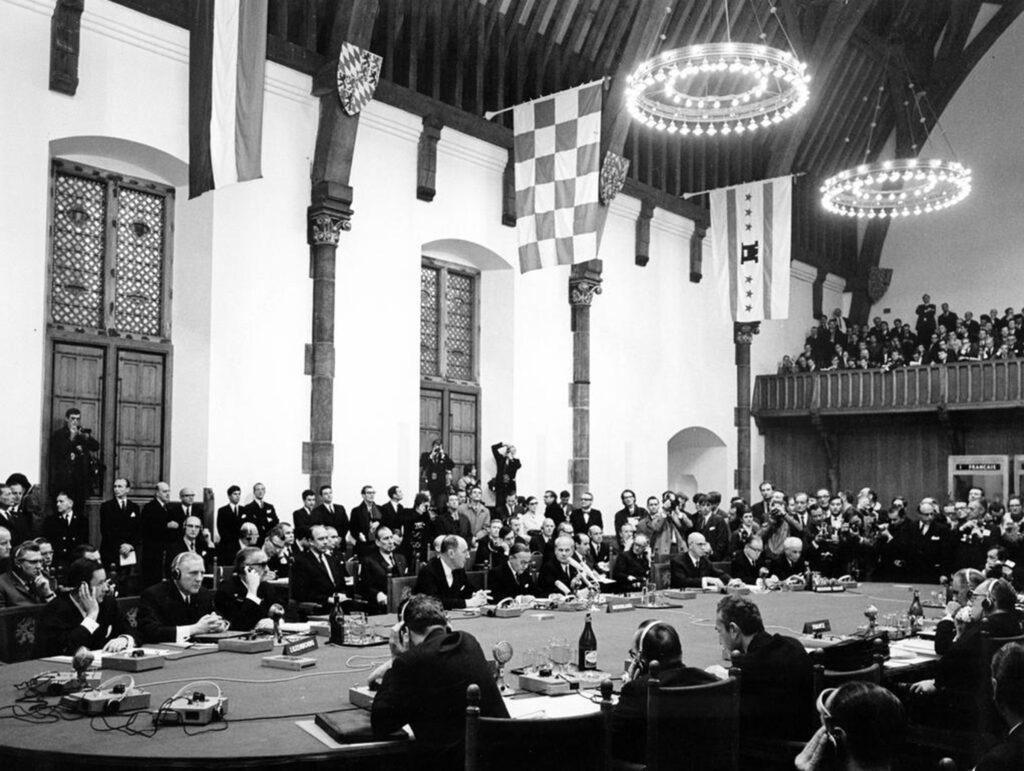
The December Hague Summit
With his retirement and replacement by Pompidou, who has switched his approach to appeal to more liberal voters, the calculus has changed. Following the Hague Summit in December negotiations have officially begun again in Luxembourg. There are a number of points that are still subject to negotiation, but things appear to be moving forward.
In the pages of Vision of Tomorrow, Europhilia is on display and it is time for me to negotiate my way through six stories: some about major nations, some involving small grand duchies, but all will be covered with sufficient weight:
Vision of Tomorrow #11

Cover by Eddie Jones
Continue reading [July 14, 1970] Hit For Six (Vision of Tomorrow #11)

by Victoria Silverwolf
Now that we're well into the first year of a new decade, it's possible to look back on the recently ended 1960's and acknowledge that it's been a time of extraordinary changes in society. Music, clothing, civil rights, the peace movement, and so forth. Even in the relatively tiny world of imaginative fiction, the so-called New Wave has hit the field like a tornado.
Many of these revolutions have been led by youths. Recently, many young people in the United States have been demanding the right to vote at the age of eighteen instead of twenty-one. (Shades of Wild in the Streets!)
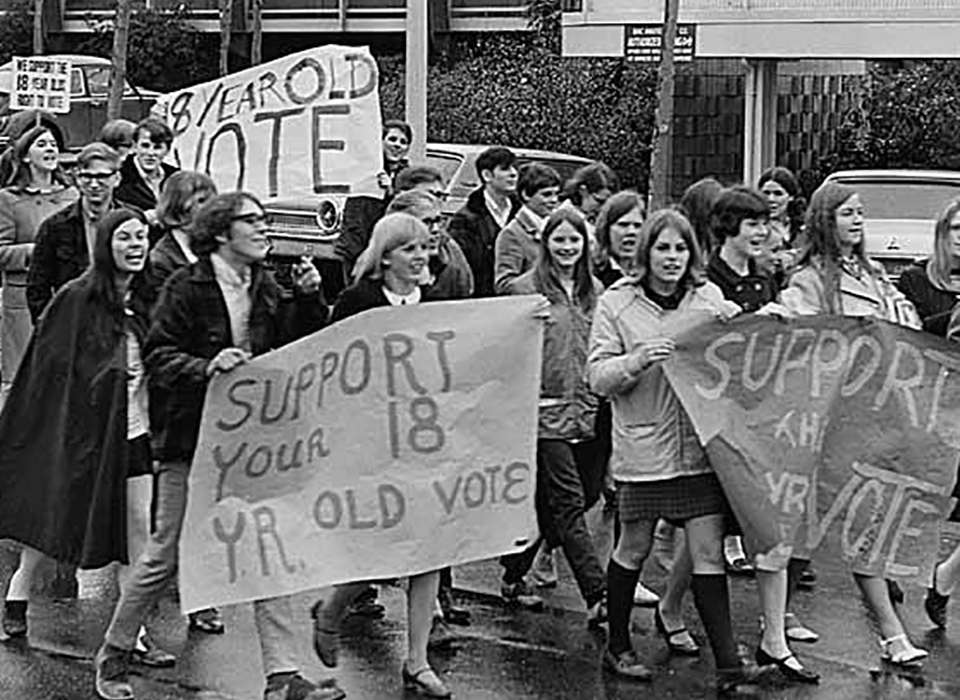
A typical demonstration promoting the lowering of the voting age. This one happened in Seattle last year.
On June 22 of this year President Nixon signed an extension of the Voting Rights Act of 1965, requiring that the voting age be eighteen in all federal, state, and local elections. However, the constitutionality of this extension is under question, so don't celebrate yet.

Nixon had doubts about the constitutionality of the extension even as he signed it, so he ordered a court case to decide the issue.
The latest issue of Fantastic reflects the changes that have been going on, with the New Wave movement influencing a great deal of fiction and nonfiction in its pages. Don't worry; there's enough Old Wave content to satisfy traditionalists as well.

Cover art by Jeff Jones. Note that the Fantastic Illustrated feature promised on the cover does not actually appear in the issue.
Continue reading [July 12, 1960] The New Generation (August 1970 Fantastic)
Tune in tonight at 7pm Pacific for the latest episode of Science Fiction Theater!

by Cora Buhlert
This is not the article I was planning to write this month. In fact, I was going to review the Ballantine Adult Fantasy collection Zotique, which reprints the haunting stories Clark Ashton Smith published in Weird Tales for the first time in more than thirty years.
However, Clark Ashton Smith will have to wait – he has been waiting for more than thirty years by now, after all – because there have been some most shocking developments in the West German leftwing sphere.
A Pleasant Spring Day in West Berlin


The Dahlem neighbourhood of West Berlin is a normally a quiet upper middle class suburb, where nineteenth and early twentieth mansions line leafy cobblestoned streets. There is little traffic here, birdsong can be heard echoing from the gardens and rarely are there sounds louder than a whirring of a lawnmower or the barking of a dog. But on May 14 at eleven AM, the quiet of Dahlem was interrupted by the sound of gunfire.
The source of those shots was a white mansion with dark green shutters, nestled in a garden with birch and pine trees on Miquelstraße. It was a warm and sunny spring day, so the windows on the ground floor were wide open. This mansion houses the library of the German Central Institute for Social Issues, i.e. not a place where anybody would expect gunfire.

Shortly after the shots, an engine howled and a car raced down the street. Georg Linke, the 62-year-old janitor of the Institute, staggered across Miquelstraße, clutching his side, only to collapse in a driveway, bleeding profusely from gunshot wounds in his arm and his abdomen. He was found by a student who wanted to consult the library.
"That was the Meinhof woman," a man in uniform yelled from the open window of the Institute, while the student yelled back they should call an ambulance, because someone had been shot.
Initially, there was some confusion about what precisely had happened at the German Central Institute for Social Issues. But gradually, it became clear that the quiet Miquelstraße had just witnessed one of the boldest prison breaks in recent German history.
Continue reading [July 10, 1970] Prison Break in West Berlin: The Liberation of Andreas Baader

By Mx Kris Vyas-Myall
More than 1,000 women marched through armed cordons in Belfast a few days ago, in a surprising display of bravery and protest. How has such an act come to be seen on British streets?

Since last summer, when British troops were called in by Stormont, the violence has continued to worsen. When the so-called “battle of the bogside” took place in August, British troops arrived too late to stop loyalist violence.
Soon after, a split emerged in December within the IRA, with there now being two groups. First are the “official” IRA, who have adopted a Marxist platform and believe in political engagement to bring about a socialist workers republic. Second are the new militant “provisional” IRA who support armed defence of Catholic communities and believe that their campaign can only end in a single united republic of Ireland. Currently, the momentum seems to be with the provisional group, particularly with increasing loyalist violence. When a member of the official IRA came out to ask a Catholic group to disperse, he was stoned by the crowd.
Things have also been going south (pun intended) in the Republic. In April, a paramilitary group (possibly the provisional IRA or Saor Eire, but unconfirmed) committed a bank robbery and shot dead an unarmed member of the Irish Garda, Richard Fallon, the first to be murdered in the line of duty since the 40s. The next month, Jack Lynch, the Irish Taoiseach, was forced to fire his ministers of finance and agriculture as they are charged with trying to supply arms to paramilitaries in the North.
As tensions continued to ramp up between communities, it was inevitable we were in for another summer of violence. In the most recent incident, it is unclear as yet who struck first. Loyalist sources say the provisional IRA were using the imprisonment of Bernadette Devlin as an excuse to whip up violence. Republican sources say a loyalist mob were trying to drive Catholics living in the Short Strand area out of East Belfast. Whatever the cause, five people died and there was a huge amount of property damage. More importantly for what happened next, members of the provisional IRA used guns to fire back against loyalists in the Falls Road area.
A curfew was declared in the area as three thousand British Army went house to house, armed and firing tear-gas, in order to check for weapons and arrest potential IRA suspects. This, however, is not something that can be done quickly (there were more houses than soldiers) or easily, and took three days to complete. As such, supplies were running low for some households, as people even leaving to get food were liable to be shot.
This is where the march came in. Local Catholic women decided to take action themselves and marched in holding food, in full view of the press. They correctly made the calculation that the British Army would not shoot women armed only with bread and milk to be broadcast on the evening news. Some were blocked but many were able to get through and resupply the community.
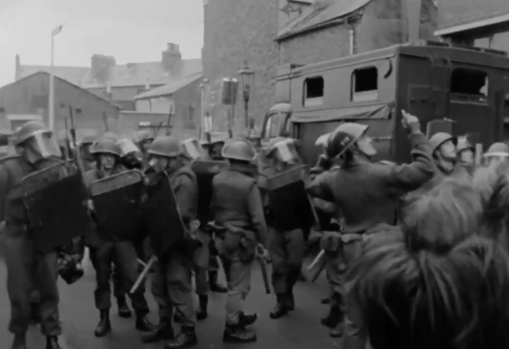
It is unclear if the British raids will have done any more than American finding of caches in Vietnam but two things are definitely clear:
1. The Catholic community in the North are not going to have much trust of the British to protect them, if any indeed still remained.
2. Protection and support for the community is coming from the ground up, particularly women in these roles, rather than top down.
One place you can also see women regularly pushing things forward is in Orbit. Whilst not quite having an equal number, it is still the only place I can be certain to see multiple women writers between its two covers.
Orbit 7 ed. by Damon Knight

Cover by Paul Lehr
Continue reading [July 8, 1970] I'm Still Marching Some More (Orbit 7)

by Gideon Marcus
Hello, Louie!
Enough talk about Cambodia, Israel, and the Race Problem. How about some happy news for a change?
Satchmo, sometimes known as Louis Armstrong, had a birthday this last Independence Day. The famed trumpter and gravel-throated crooner, known for his ear-splitting smile and breaking racial barriers, has just finished his seventh decade.
"It's awful nice to be breathing on your 70th birthday, let alone feeling in the pink," he observed.

A big tribute was held in Los Angeles' Shrine Auditorium for Armstrong on July 3rd, perhaps the most influential jazz musician since the genre was born. While he did not puff his cheeks to blow his horn (he is still recovering from a kidney infection), he did sing for his audience, joined by a number of fellow jazz greats. Proceeds from the event will go to the Louis Armstrong Statue Fund.
So, happy birthday to New Orleans' favorite son. What a wonderful world.
Hello, Jimmy!
As Galaxy approaches its 20th birthday, I see it has reverted to the format the magazine took back in 1958: it is once again an overlarge bi-monthly (like sister mag IF, which means we essentially get three mags every two months). On the one hand, this makes room for bigger pieces, like the superlative story that headlines this month's issue. On the other hand, it means more room for dross like Heinlein's new serial that taillines the book.
Read on. You'll be grateful I did the screening for you…
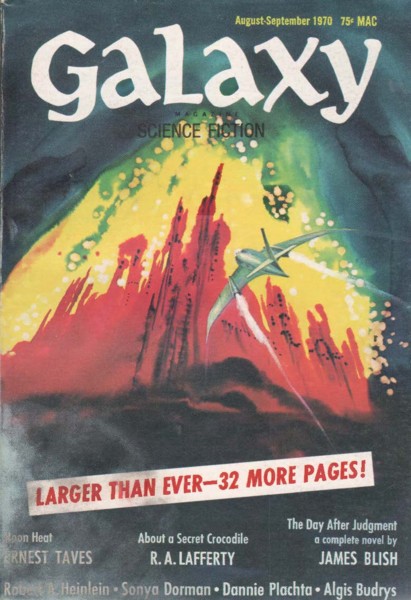
Cover by Jack Gaughan
Continue reading [July 6, 1970] The Day After Judgment (August/September 1970 Galaxy)

by Brian Collins
Our journey through this long (560 pages, in fact) and ambitious anthology continues. The Science Fiction Hall of Fame, Volume One is, as Robert Silverberg more or less explains it, a survey of short genre SF from the Gernsback years up to just before the founding of the Science Fiction and Fantasy Writers of America. These 26 stories are a mix of those the SFWA voted on and those which Silverberg had chosen at his own discretion. The oldest story here, Stanley Weinbaum's "A Martian Odyssey," was published in 1934, while the newest, Roger Zelazny's "A Rose for Ecclesiastes," appeared relatively recently, in 1963. Most of these stories appeared prior to the Journey's advent.
Last time we read "Mimsey Were the Borogoves," a splendid story by C. L. Moore and the late great Henry Kuttner, under one of their joint pseudonyms. What do the next nine stories have in store for us?
Huddling Place, by Clifford D. Simak
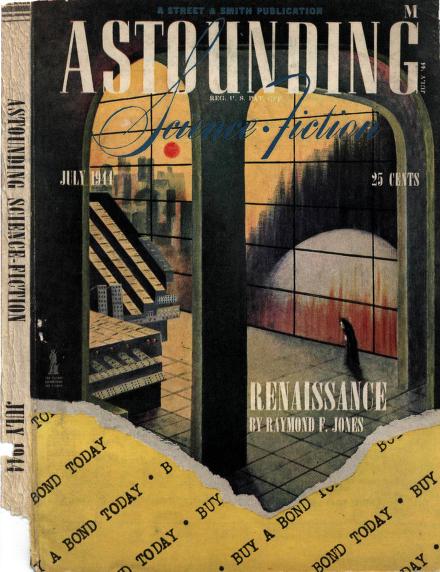

by David Levinson
A piece of the rock
Anyone who pays more than casual attention to U.S. domestic news is probably aware of the Black Power movement, but how many have heard of the Red Power movement? Those whose ancestors were in what is today the United States have been shamefully treated. They’ve been repeatedly driven from their homes and sacred lands, seen treaty after treaty ignored and violated, been robbed of their languages and religions, and much more. Now some of them are trying to regain some of what they’ve lost.
Back in 1963, the federal prison on the island of Alcatraz in San Francisco Bay was declared no longer fit for purpose and shut down. A Sioux woman living in the area recalled that the 1868 Treaty of Fort Laramie promised that land occupied by the federal government would revert to the native peoples if it was no longer in use. In March of the following year, she and several others staged a four-hour occupation of the island and filed a claim. They left when threatened with felony charges.
Last October, a fire destroyed the San Francisco Indian Center, and the loss of the space reminded Native Americans in the Bay Area of one of the proposals for the use of Alcatraz by those earlier protesters. On November 20th, a group of 89 people calling themselves Indians of All Tribes set out to reach Alcatraz, with fourteen of them successfully reaching the island. They have since been joined by many more; there are a few hundred people there now.
 Some of the occupiers a few days after arriving on Alcatraz.
Some of the occupiers a few days after arriving on Alcatraz.
There have been difficulties. Water and electricity are particular problems. Many hippies flocked to the island until non-Indians were prohibited from staying overnight. A fire in early June destroyed several buildings. And in May, the government began the process of transferring Alcatraz to the National Park System in order to blunt the occupiers’ claim.
However, they’ve garnered a lot of attention and support, including from many celebrities. They have also inspired other protests in favor of Indian rights. After a Menominee woman in Chicago was evicted following a rent strike over repairs not being made, a protest camp was set up in a nearby parking lot, starting with a tepee borrowed from the local American Indian Center. Since it’s right next to Wrigley Field, where the Cubs play baseball, it’s gotten a lot of attention and has been dubbed “little Alcatraz” in the local press.
Will all of this achieve anything? Maybe. The scuttlebutt in Washington is that Nixon is planning a proposal to Congress sometime this month regarding Indian rights. There are no details right now, but it’s expected that he will call for greater self-determination and an end to forced assimilation.
Continue reading [July 2, 1970] Matters of conscience (August 1970 Venture)